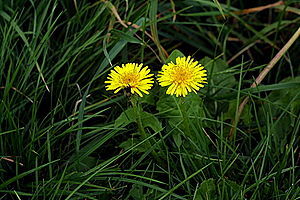 Image via Wikipedia
Image via Wikipedia "Dandelion
Oh, hardy flower, disdained as weed,
Despised for head of feathery seed,
Your unsung virtues rate a ballad,
Choice roots for wine, crisp leaves for salad."
-Betty Gay, Cookbook Editor
-Betty Gay, Cookbook Editor
Dandelions. A bane to suburban lawns everywhere. Not only did they inflame my mother’s allergies, but they also were the nemesis of suburban lawns everywhere. Nothing said déclassé than a dandelion filled lawn. My mother went to extreme lengths to get rid of them. Pesticides, lawn mowers, Garden Claw™, indentured servitude (meaning us kids). But it was a Sisyphean battle. For every dandelion we got rid of, more would appear. (It didn’t help that we would pluck the seed heads and blow on them, making their proliferation a foregone conclusion.)
But in the spirit of “you can eat that,” dandelions, genus Taraxacum, are one of the easiest plants for the urban forager. The ease is due to their biological hardiness, their taxonomic spread (nearly 34 macrospecies and 2000 microspecies) and their simplicity of reproduction (asexual). Their root systems run deep, surviving up to 7 years, even if no other visible parts of the plant remain. Furthermore, this root system will bring much-needed minerals and nitrogen to poor soils and shallow-rooting plants. These characteristics make them a pioneer species in disturbed soil or in areas of reduced tillage. Furthermore, insects use dandelions as nectar source (why so many bees are around dandelions) and the seeds are eaten by a myriad of bird species, which allows for their seeds to be dispersed over a large range of land.
Most commonly used as a homeopathic remedy for liver and bile problems, as well as a general anti-inflammatory.[1] Many eat dandelion leaves in salad, such as the Greeks and the Italians. It is used in making “dandelion wine” (in parts of Appalachia in the Eastern United States) and the roots are roasted and ground as ersatz coffee. What many do not know is that both Korean and Chinese use dandelion greens often in cooking, using them as a side dish and as an ingredient in soups. They can also be used in a number of ways that arugula or other bitter greens can, for example, in pesto or as ravioli filling.
When gathering dandelion greens for culinary purposes, there are a couple of things you should do. First, follow the general foraging rules on my previous post (http://www.edo-ergo-sum.com/2011/05/who-are-plants-in-your-neighborhood.html). Second, look for small newly sprouted leaves (Large leaves have a high potassium content, and are quite bitter). This means you should pick your leaves in early spring or fall when they start to emerge from the ground. And third, you will need a lot of them – about a large bag or basket-full of leaves, as they wilt considerably while cooking.
Next time you see a dandelion, don’t think useless weed – think food and maybe your attitude towards the lowly dandelion will change.
Sautéed Korean Dandelion Greens
Koreans use this dish as part of the small dishes called banchan that are traditionally served at every meal. You can use this as a side dish to accompany Asian dishes or with the addition of some protein (chicken, tofu or whatever you have on hand), it can make a tasty meal with some rice (I like short grain brown rice). Make sure you rinse your leaves thoroughly, as they tend to sandy. And if you have slightly older plants, you may want to blanch twice, as to remove as much bitterness as possible.
1 large bag/basket of dandelion greens (about 8-10 oz.)
1 tbs. neutral vegetable oil
1 clove garlic, finely minced
1-2 tbs. soy sauce (use Korean soy sauce, if possible)
1 tsp. sugar
1 tbs. toasted sesame oil
3 tbs. toasted sesame seeds (toast seeds in dry pan until brown)
1. Boil a large pot of water. Blanch dandelion greens until wilted – about 10 seconds. Drain thoroughly and set aside.
2. In a small bowl, combine soy sauce and sugar until the sugar dissolves. In a non-stick skillet, heat vegetable oil until shimmering over medium-high heat. Add garlic and sauté briefly until fragrant. Add greens and sauté for 1-minute, then add soy mixture to the pan and sauté a minute more.
3. Take off heat, and toss with sesame oil and sesame seeds. Serve warm or cold with rice.
[1] I am not really the best advocate for homeopathy. While I think that many plants have pharmaceutical benefits, I need a double-blind test to verify their usefulness. Once a scientist, always a scientist.
